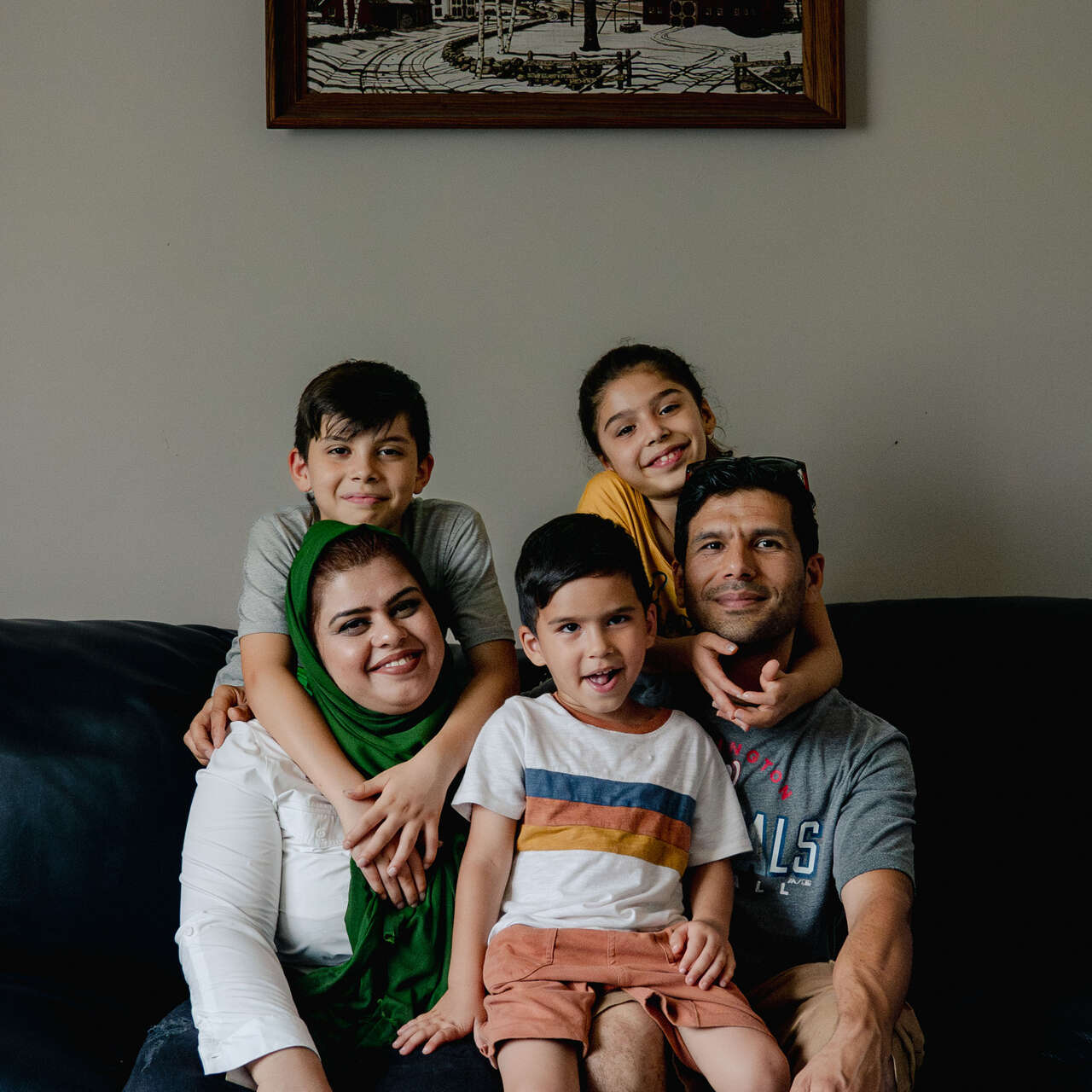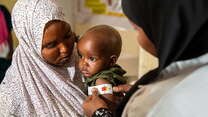Refugees are men, women and children who have fled their home country due to war, persecution or political upheaval. Some eventually return when it’s safe to do so, others stay in temporary refugee settlements or integrate into nearby countries offering asylum, while a tiny fraction resettle in a third country, such as the United States.
Learn how refugee resettlement works, how the IRC helps and what you can do to support refugees.
The US Refugee Admissions Program is managed by the U.S. government, which works with the United Nations Refugee Agency and designated humanitarian agencies to identify, screen and vet prioritized populations for resettlement.
The U.S. accepts a limited number of refugees each year. The president, in consultation with Congress, decides the target level of refugee admissions for a given year and issues this decision via a Presidential Determination. During the first Trump Administration, the refugee admissions program was slashed by more than 85%, with record-low admission caps set nearly every year: 45,000 for 2018; 30,000 for 2019, 18,000 for 2020 and just 15,000 for 2021.
These numbers indicate a stark decline from the average annual admissions cap of 95,000 under both Republican and Democratic administrations since the program was founded.
However, the Biden administration made important progress in rebuilding the nation’s refugee resettlement program, including raising the refugee admission cap to 62,500 in fiscal year 2021 and 125,000 in fiscal years 2022-2024.
The incoming Trump administration should recognize the moral, strategic, and practical imperatives of maintaining resettlement as a safe and regular pathway, which has been used for decades to protect religious minorities, American allies, and political dissidents fleeing repressive regimes.
Learn how the refugee admissions cap is determined.
Applicants for refugee admission to the U.S. must satisfy the following criteria:
- Meet the definition of a "refugee" as determined by U.S. government officials.
- Be determined to be of special humanitarian concern to the U.S.
- Pass intensive security vetting.
- Not be firmly resettled in any foreign country.
Although a refugee may meet the above criteria, the existence of the U.S. Refugee Admissions Program does not create any entitlement for that person to be admitted to the U.S.
The hardest way to come to the U.S. is as a refugee.
Refugees are vetted more intensively than any other group seeking to enter the U.S. All those seeking to come here must first be registered by the United Nations Refugee Agency, which identifies people most in need. The U.S. then hand-selects every person who is admitted.
The program does not admit people who have committed violations of humanitarian and human rights law.
Security screenings are intensive and led by U.S. government authorities, including the FBI, the Department of Homeland Security, the Department of Defense, and other security agencies. The process can take years and is followed by further security checks after refugees arrive in the States.
Resettlement Support Centers (RSC), run by agencies like the IRC through cooperative agreements with the Department of State, help refugees and their families prepare their cases for processing and security vetting, including by compiling personal data for interviews with officials from the Department of Homeland Security (DHS).
Once refugees have been cleared for resettlement, the U.S. government works with the IRC and nine other national resettlement agencies to help them restart their lives in America.
Refugees may be placed in a city where they have relatives or friends, or where there’s an established community that shares their language or culture. Other considerations include the cost of living and access to medical services. However, as legal U.S. residents, refugees may ultimately live in any state they choose.
Preparation for travel
Before refugees leave the countries where they temporarily reside, they sign promissory notes agreeing to reimburse the U.S. government for travel costs. They also attend a class to learn about what to expect when they arrive in their new country, with briefings on American culture, U.S. laws, healthcare access and other critical information. Officials also conduct a final screening and additional security checks before departure.
Arrival in the U.S.
Refugees are greeted and welcomed at the airport by case workers from resettlement agencies like the IRC to ensure their transition is as comfortable as possible. Agencies are responsible for finding a suitable, affordable home for refugee families, something many of these refugees have gone without for years. Families also receive basic furnishings, food and other immediate assistance for a limited period of time.
Through initiatives like Welcome Corps, Americans across the country can also offer a lifeline to safety by sponsoring refugees and supporting their the resettlement process.
Learn more about the Welcome Corps and find out how you can get involved.
Getting on their feet
For the first 90 days, resettlement agencies work with state and local governments and community organizations to help new arrivals settle into their communities.
- Refugees are introduced to their local health care system. Although they have had thorough check-ups before entering the U.S., they receive additional examinations by medical professionals in their new communities.
- Learning English is an essential step to becoming self-sufficient. Agencies help assist refugees to enroll in English courses at their local offices or help families find classes nearby.
- Newly arrived refugees have endured years of trauma and hardship; that emotional burden does not lift once they’re in the U.S. Agencies, service providers and local communities work together to help survivors of violence and human trafficking receive the support and care they need in order to recover.
- Parents are informed about schooling options and caseworkers help to enroll children in school. Aid agencies help ensure each child has a backpack, notebooks and other supplies for their first day.
- Refugees receive stipends to cover their first three months in the U.S., but they are encouraged to find work quickly—and most do. Agencies reach out to local employers, some run by former refugees or other immigrants, to find job opportunities for them. Refugees can also receive support in putting together their resume and preparing for job interviews.
Once they acclimate to their new environment, refugees often thrive and contribute to their communities, starting careers, purchasing homes and building businesses.
The IRC has 29 offices across the United States that support newly arrived refugees by providing immediate aid, including food, housing and medical attention.
Each resettlement office serves as a free, one-stop center for refugees’ needs during their pivotal first months in the U.S. Through a network of staff members and volunteers, the IRC helps refugees learn about life and customs in America, secure jobs, and learn English. We provide most of the basic things they need to restart their lives here and help them overcome cultural barriers so that their adjustment is as easy as possible.
Through community gardening, nutrition education and small-business farming, the IRC's New Roots program gives hundreds of refugee farmers the tools and training they need to grow healthy and affordable food and become self-sufficient.
Refugees are encouraged to find work quickly and stand on their own feet — and most do. Refugees even pay back the loans they take for their plane tickets here.
The IRC works in more than 40 countries and in 29 U.S. cities to help people affected by humanitarian crises survive, recover and rebuild their lives. Learn more about our U.S. offices:
- Abilene, TX
- Atlanta, GA
- Baltimore, MD
- Boise, ID
- Charlottesville, VA
- Dallas, TX
- Des Moines, IA
- Denver, CO
- Elizabeth, NJ
- Los Angeles, CA
- Louisville, KY
- Miami, FL
- Missoula, MT
- New York, NY
- Oakland, CA
- Phoenix, AZ
- Richmond, VA
- Sacramento, CA
- Salt Lake City, UT
- San Diego, CA
- San Jose, CA
- Seattle, WA (SeaTac, WA)
- Silver Spring, MD
- Spokane, WA
- Tallahassee, FL
- Tucson, AZ
- Turlock, CA
- Wichita, KS
Everyone can help refugees by welcoming them as new and valuable members of American society.
You can help refugees by volunteering at a local resettlement agency; becoming an English tutor, or a mentor to a family; donating money, furniture and household items; teaching other people about refugees; urging your elected officials to support refugee resettlement; and by employing or encouraging local businesses to employ refugees.
Ways to help right now:
- Help the IRC support refugee families in crisis with a donation: Donate now
- Take action. Tell President Biden that you are ready to welcome refugees today.
- Look for IRC volunteer opportunities assisting refugees in the U.S.
- Sponsor a refugee family.
- Rent to refugees.





